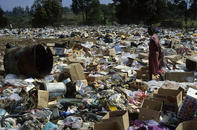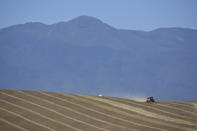Avenues to Get Food
Around the world, one third of all food that is produced for human consumption gets wasted at some point between the harvesting machine and the dinner plate. One third. And this in a world where over a billion people are going hungry.

While some communities are throwing stale food out of their fridges because they over-catered for the week, others are picking through landfill sites looking for their next meal, and eating rotten food directly from city garbage heaps. We cannot keep wasting food, or the resources and ecosystem services used to produce that food, the way we are now. While some may borrow food from within their community, others, like those in some communities, might enjoy a temporary boon of a local pastor’s generosity. The man of God’s child arrives unexpected during the morning, wearing a red hooded sweatshirt with the words ‘Tough Machine Demolition Team 33’ tottering in kindergarten font above a lilac front-end loader. She and a friend come bearing gifts: mealie meal, rice, beetroot and some beef chops, crammed into the clear plastic tubs with a splash of gravy over the top. It is about an hour after the children in the community have dispatched their own bread and sugar water, so filling, tasty food is probably a welcome sight.
Five children squat down next to a yard tap and dispatch the food with a series of controlled but no less eager dives at the meal, some scooping it up using four fingers to ladle it into their mouths. When the gaps in the mesh of an extended community’s safety net become too big, when all other avenues to get food are used up, a last resort is to pick up other people’s discarded food.
The local rubbish dump is the very end of the road for food waste, but for some of southern Africa’s poorest, it is a regular source of the only nourishment they will get. The global food crisis has been creeping steadily towards the centre of the world’s attention since a confluence of events that pushed 2008’s food prices to levels that triggered riots in many cities around the world. Increasing alarm about high food prices and regional shortages has pulled the focus in on the matter of food waste and how much it contributes to the problem.
Grotesque Wastage
Across the food value chain – from the crop ripening in the field, or the lamb fattening up in the pasture, through to harvesting or slaughtering, to shipping, processing, packaging, shipping on to the retailer, standing around on shelves or in fridges, passing the checkout scanner, rattling out into the parking lot in a shopping trolley, to the consumer’s plate and then, possibly, the bin – massive amounts of food are wasted globally.
According to a recent study by the United Nation’s Food and Agriculture Organisation (FAO), as much as a third of all the food produced for human consumption around the world is lost to the human belly. The reasons are complex, and vary depending where on the supply chain the waste, loss or spoilage occurs.
But the result is nevertheless ‘grotesque’, to borrow the description from author Tristram Stuart who wrote about it in Waste: Uncovering the Global Food Scandal. Of all the food produced globally each year, 1.3 billion tonnes of it does not make it into someone’s stomach. And this occurs in the context of a world where 1 billion people are still undernourished, and who ‘could be fed with just a fraction of the food that rich countries currently throw away’, according to Stuart.
Food Wastage Figures
A distinct pattern emerges in the food waste story, one which, unsurprisingly, divides food farmed for the rich from the food that is farmed for the poor. The FAO study, conducted for the organisation by the Swedish Institute for Food and Biotechnology, divides discarded food into two categories: all the food that goes into the bin between farmer and retailer – essentially, at production, post-harvest and processing stages – is lumped together as ‘food loss’.
Meanwhile ‘food waste’ is everything lost between the retailer and the consumer. In rich countries, because such sophisticated systems of production and shipping buoy the food supply chain, losses are low from farmer to retailer. But this means large amounts of food arrive at the retailer, where they are met by stringent quality standards, along with wealthy consumers who tend to buy much more than they need.
For every European or North American, about 900 kilograms of food is produced per person, per year. Of that, a total of 280–300 kilograms per person per year gets thrown into the bin somewhere between the harvesting process and when the person clears his or her plate (this refers to food losses as well as wasted food, according to the FAO report’s definition). This accounts for over 40% of all the food that does not make it into someone’s belly in the rich countries.
The figure is not far below the per capita production in sub-Saharan Africa of 460 kilograms per person, per year. To reiterate: sub-Saharan Africa produces an annual 460 kilograms of food for every person walking that part of the continent; for every European or North American, up to 300 kilograms of food is lost to the dinner plate across the food value chain each year.
In developing countries, the situation is reversed. Most of the total food loss happens between farmer and retailer – meaning over 40% of all food lost in poor countries happens at harvesting, post-harvest, production and shipping. In sub-Saharan Africa, this amounts to 120 kilograms per person annually.
But by the time this reaches the retailer, it is often going to a poorer consumer who will buy just what he or she needs, and cannot afford to allow food to go to waste. So there is very little food getting thrown out by poorer homes. Only 6 kilograms of food gets wasted per person in sub-Saharan Africa.
Rich Countries vs Developing Countries

In rich countries, consumers throw out as much as half of all cereal foods. As for seafoods, up to 15% is lost in richer countries because of the wrong species being caught up in nets – euphemistically called ‘by-catch’ – and thus getting thrown overboard or else it is thrown out at the household level.
In poorer countries, perishing of fish during distribution is where the bulk of losses occur in this sector. When it comes to fruits and vegetables, grading and quality standards set by retailers have become stringent to the point of absurd in some regions (for instance, carrots that are not straight enough to be peeled in a single stroke).
That, together with over-buying by consumers, accounts for up to 30% of fresh produce that gets tossed out. High meat consumption in richer countries, along with large amounts of waste between retailer and consumer, accounts for vast volumes of wastage in meat and meat products in industrial countries.
But for developing countries, death of animals due to disease on the farm is where most losses occur in this commodity sector. Consumers throwing out milk accounts for up to 65% of food waste in richer countries, whereas milk spoilage in poorer countries takes place mostly at handling, storage and distribution levels.
In summary: out of every 4 600 calories of edible crop harvested, only 2 000 calories make it onto the dinner plate; 600 of those original calories are lost shortly after harvesting; then another 1 200 calories are fed to livestock for meat and dairy production; and another 800 calories are wasted on the way through the market chain.
The contradictions in the food system, its associated waste and the considerable uneven distribution of calories around the globe could not be better demonstrated than by placing side by side the frame of the average United States citizen, where obesity is beginning to reverse modern gains in life expectancy, with the emaciated form of someone in a northern Kenyan refugee camp as the 2011 famine in the Horn of Africa has driven thousands of people to the brink of death.
Not Just a Waste of Food
According to the United Nations FAO report in May 2011, rich countries waste almost as much food, 222 million tonnes, as sub-Saharan Africa’s net food production each year, 230 million tonnes. But it is not just the grotesque unfairness that this juxtaposition demonstrates.
Every calorie of food wasted (particularly in rich communities, even here in southern Africa, who are responsible for their fair share of it) does not just underscore the suffering of another person going without food somewhere else, but rather it is wasteful at a much larger scale: the nutrients in the soil used to grow that calorie are wasted, the water to grow the crop, the oil used to plough or fertiliser the land, more diesel used to harvest the crop, energy spent on processing or shipping the food, and the ever-shrinking atmospheric space used to soak up all the greenhouse gas emissions.
Food production uses plenty of finite resources, such as oil reserves, potassium for fertilising, and it uses environmental systems – water generation, waste sinks, the carbon mopped up by the atmosphere, all of which need to be used more and more sparingly. To deplete those reserves in the production of food that lands in a bin is highly problematic and unsustainable.
And the cost of producing, shopping, storing and packaging every wasted calorie has to be absorbed somewhere else in the food value chain, which ultimately drives up the cost of food itself. Obviously, solving the waste issue is not as simple as diverting food from places of excess to places of want, before the food perishes.
Tristram Stuart puts it succinctly in his preamble to Waste: Uncovering the Global Food Scandal: ‘The connection between food profligacy in rich countries and food poverty elsewhere in the world is neither simple nor direct. .. the solution is not for rich countries to send old tomatoes or stale bread over to poor countries after saving them from the rubbish bin.
Instead. .. in a global food market in which rich and poor countries buy food from a pool of internationally traded commodities, we are all essentially buying food from the same common source. If rich countries buy hundreds of millions of tonnes of food and end up throwing these into the bin, they are gratuitously removing food from the market which could have remained there for other people to buy.’
By Leonie Joubert